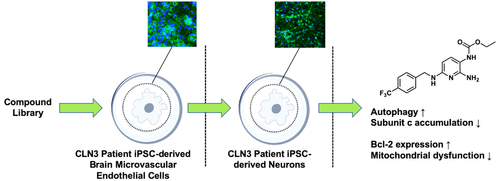当前位置:
X-MOL 学术
›
ACS Pharmacol. Transl. Sci.
›
论文详情
Our official English website, www.x-mol.net, welcomes your
feedback! (Note: you will need to create a separate account there.)
An iPSC-Derived Neuron Model of CLN3 Disease Facilitates Small Molecule Phenotypic Screening
ACS Pharmacology & Translational Science ( IF 4.9 ) Pub Date : 2020-09-01 , DOI: 10.1021/acsptsci.0c00077 Nihar Kinarivala 1 , Ahmed Morsy 2 , Ronak Patel 1 , Angelica V Carmona 2 , Md Sanaullah Sajib 1 , Snehal Raut 1 , Constantinos M Mikelis 1 , Abraham Al-Ahmad 1 , Paul C Trippier 1, 2, 3
ACS Pharmacology & Translational Science ( IF 4.9 ) Pub Date : 2020-09-01 , DOI: 10.1021/acsptsci.0c00077 Nihar Kinarivala 1 , Ahmed Morsy 2 , Ronak Patel 1 , Angelica V Carmona 2 , Md Sanaullah Sajib 1 , Snehal Raut 1 , Constantinos M Mikelis 1 , Abraham Al-Ahmad 1 , Paul C Trippier 1, 2, 3
Affiliation

|
The neuronal ceroid lipofuscinoses (NCLs) are a family of rare lysosomal storage disorders. The most common form of NCL occurs in children harboring a mutation in the CLN3 gene. This form is lethal with no existing cure or treatment beyond symptomatic relief. The pathophysiology of CLN3 disease is complex and poorly understood, with current in vivo and in vitro models failing to identify pharmacological targets for therapeutic intervention. This study reports the characterization of the first CLN3 patient-specific induced pluripotent stem cell (iPSC)-derived model of the blood-brain barrier and establishes the suitability of an iPSC-derived neuron model of the disease to facilitate compound screening. Upon differentiation, hallmarks of CLN3 disease are apparent, including lipofuscin and subunit c of mitochondrial ATP synthase accumulation, mitochondrial dysfunction, and attenuated Bcl-2 expression. The model led to the identification of small molecules that cleared subunit c accumulation by mTOR-independent modulation of autophagy, conferred protective effects through induction of Bcl-2 and rescued mitochondrial dysfunction.
中文翻译:

CLN3 疾病的 iPSC 衍生神经元模型促进小分子表型筛选
神经元蜡样脂褐质沉积症 (NCL) 是一类罕见的溶酶体贮积症。最常见的 NCL 形式发生在CLN3基因突变的儿童身上。这种形式是致命的,除了症状缓解之外,目前没有治愈或治疗方法。CLN3 疾病的病理生理学复杂且知之甚少,目前在体内和体外模型未能确定治疗干预的药理学目标。本研究报告了第一个 CLN3 患者特异性诱导多能干细胞 (iPSC) 衍生的血脑屏障模型的特征,并确定了该疾病的 iPSC 衍生神经元模型的适用性,以促进化合物筛选。分化后,CLN3 疾病的特征很明显,包括脂褐素和线粒体 ATP 合酶积累的亚基 c、线粒体功能障碍和 Bcl-2 表达减弱。该模型导致鉴定出通过 mTOR 非依赖性自噬调节清除亚基 c 积累的小分子,通过诱导 Bcl-2 赋予保护作用并挽救线粒体功能障碍。
更新日期:2020-10-11
中文翻译:

CLN3 疾病的 iPSC 衍生神经元模型促进小分子表型筛选
神经元蜡样脂褐质沉积症 (NCL) 是一类罕见的溶酶体贮积症。最常见的 NCL 形式发生在CLN3基因突变的儿童身上。这种形式是致命的,除了症状缓解之外,目前没有治愈或治疗方法。CLN3 疾病的病理生理学复杂且知之甚少,目前在体内和体外模型未能确定治疗干预的药理学目标。本研究报告了第一个 CLN3 患者特异性诱导多能干细胞 (iPSC) 衍生的血脑屏障模型的特征,并确定了该疾病的 iPSC 衍生神经元模型的适用性,以促进化合物筛选。分化后,CLN3 疾病的特征很明显,包括脂褐素和线粒体 ATP 合酶积累的亚基 c、线粒体功能障碍和 Bcl-2 表达减弱。该模型导致鉴定出通过 mTOR 非依赖性自噬调节清除亚基 c 积累的小分子,通过诱导 Bcl-2 赋予保护作用并挽救线粒体功能障碍。











































 京公网安备 11010802027423号
京公网安备 11010802027423号